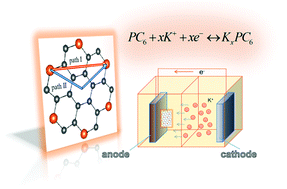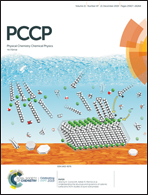Prediction of two-dimensional PC6 as a promising anode material for potassium-ion batteries†
Abstract
Due to the intrinsic safety and high abundance of potassium, the development of potassium-ion batteries has generated a surge of interest. Currently, the key challenge in this field is the lack of suitable anode materials. Here, based on first-principles calculations, we report the identification of a promising candidate in the PC6 monolayer. The PC6 monolayer is a semiconductor, but with a rather small band gap, and becomes metallic upon adsorbing K atoms, suggesting its good electrical conductivity during the battery cycle. It exhibits a high storage capacity of 781 mA h g−1, superior to those of many other reported anode materials for potassium-ion batteries. Meanwhile, it shows a low diffusion energy barrier and open circuit voltage. Moreover, the PC6 monolayer has a relatively small Young's modulus, showing potential for application in flexible batteries. These appealing properties render the PC6 monolayer an excellent anode candidate for potassium-ion batteries.



 Please wait while we load your content...
Please wait while we load your content...